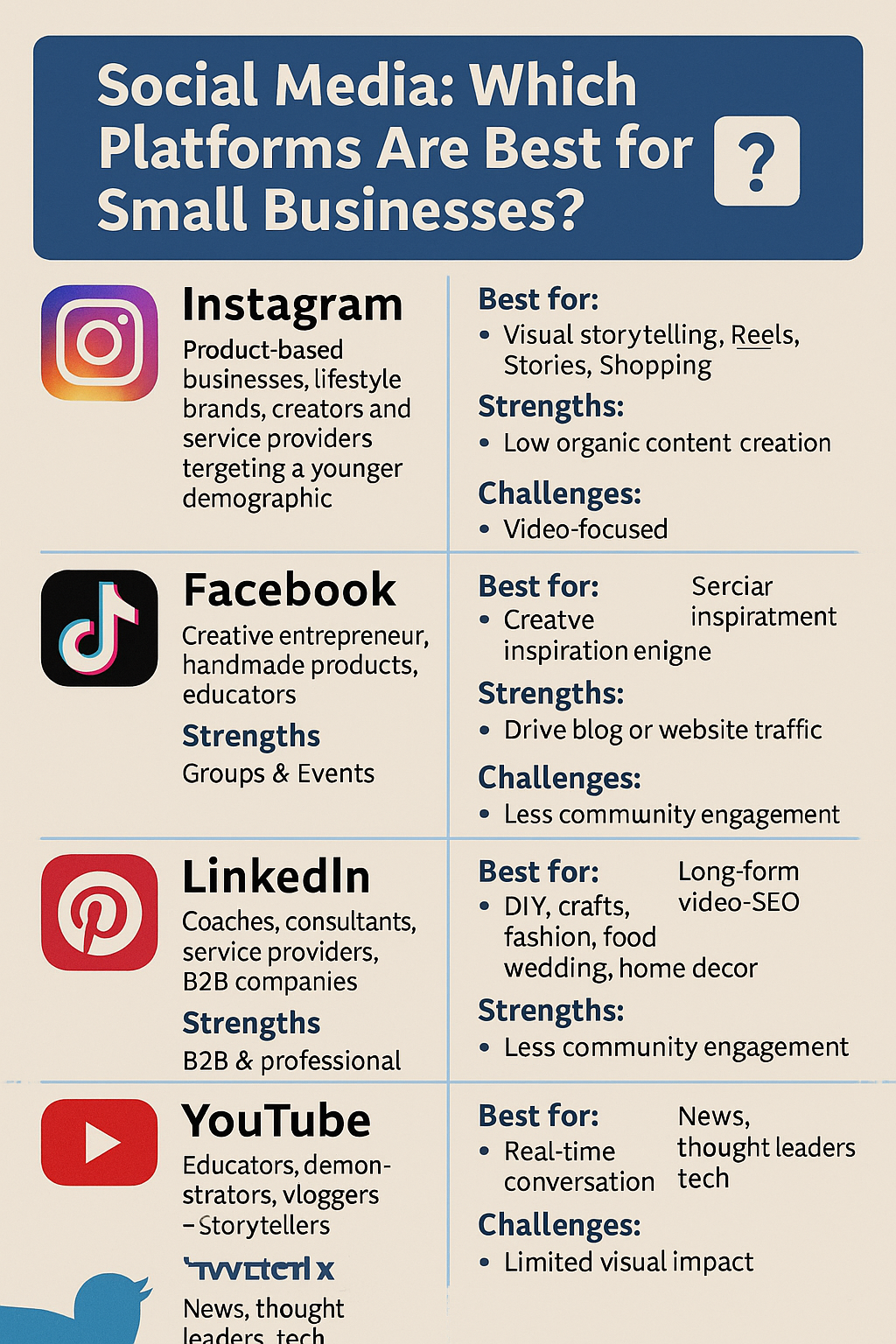With so many social media platforms available today, it’s easy for small business owners to feel overwhelmed. Should you be on Instagram? Is TikTok worth your time? What about LinkedIn or Facebook?
The truth is: you don’t need to be everywhere — you need to be where your audience is. This article will break down the strengths and weaknesses of the major platforms, so you can choose the right ones for your business, especially when time and resources are limited.
Why Social Media Matters for Small Businesses
Before diving into specific platforms, let’s quickly understand why social media is so valuable:
- It’s free to start and low-cost to grow.
- It allows for direct engagement with your audience.
- It helps you build brand trust and personality.
- It offers tools for selling, advertising, and support.
- It levels the playing field — small businesses can compete with big brands through smart content.
Now, let’s compare the major platforms to help you decide which ones are worth your focus.
Instagram: Visual Storytelling & Community Building
Best for: Product-based businesses, lifestyle brands, creators, and service providers targeting a younger demographic.
Strengths:
- Highly visual — perfect for showcasing products or behind-the-scenes content.
- Reels help you go viral and reach new people.
- Stories and Lives allow for direct engagement.
- Great tools for e-commerce, including product tags and shopping.
Challenges:
- Requires consistent content creation (images, Reels, Stories).
- Can be competitive in saturated niches.
Use it if your business benefits from strong visuals, or you want to build a strong community feel.
Facebook: Groups, Events, and Local Discovery
Best for: Local businesses, community-driven brands, older demographics (35+), or anyone selling directly through conversation.
Strengths:
- Facebook Groups help build strong, loyal communities.
- Ideal for events, local deals, or neighborhood services.
- Good integration with Instagram and WhatsApp.
- Facebook Marketplace can drive direct sales.
Challenges:
- Organic reach for business pages is very low without paid ads.
- The platform is aging — younger users prefer other apps.
Use it if you’re targeting local customers or have a strong community-based brand.
TikTok: Viral Growth & Short-Form Video
Best for: Creative entrepreneurs, handmade products, educators, and anyone comfortable on camera.
Strengths:
- Fastest-growing platform with high engagement.
- Content can go viral even with few followers.
- Authentic, fun, and informal tone is encouraged.
- Great for showing how things are made or used.
Challenges:
- Video-focused — you must get comfortable with video content.
- Trends move quickly and require staying updated.
Use it if you’re open to experimenting and want to reach a broader (and often younger) audience.
LinkedIn: B2B and Professional Networking
Best for: Coaches, consultants, service providers, and B2B companies.
Strengths:
- Great for thought leadership and building credibility.
- Organic reach is strong, especially with valuable content.
- Ideal for finding partnerships, clients, or collaborations.
Challenges:
- Not suitable for highly visual or informal businesses.
- Requires more polished, professional content.
Use it if you offer services to other businesses or are building a personal brand in a professional space.
Pinterest: Searchable Inspiration Engine
Best for: DIY, crafts, fashion, food, wedding, home decor, and digital products.
Strengths:
- Pins are searchable and have a long lifespan.
- Drives traffic to websites and blogs.
- Users come with purchase intent (especially in niches like home, wedding, and wellness).
- Great for affiliate marketing and content strategy.
Challenges:
- Not ideal for real-time engagement or community building.
- Requires good design skills or templates for Pins.
Use it if you have visually appealing products or offer tutorials, guides, or resources.
YouTube: Long-Form Video and SEO
Best for: Educators, demonstrators, vloggers, and businesses with strong storytelling.
Strengths:
- Second-largest search engine after Google.
- Perfect for building trust through in-depth videos.
- Evergreen content can generate leads for years.
- Monetization potential through ads and affiliate marketing.
Challenges:
- Requires more effort in filming, editing, and consistency.
- Growth can be slow without good SEO and thumbnails.
Use it if you’re serious about video content and want long-term brand visibility.
Twitter/X: Real-Time Conversation
Best for: News-related businesses, thought leaders, tech brands, and writers.
Strengths:
- Great for real-time interaction and building thought leadership.
- Useful for engaging in trending topics and niche communities.
- Short-form content makes posting faster.
Challenges:
- Limited visual impact.
- Less traction for direct sales.
Use it if you want to network, share opinions, or join conversations in specific industries.
Threads and New Platforms: Watch and Wait
Emerging platforms like Threads (by Meta) or Bluesky are still developing. While it’s exciting to try something new, most small business owners are better off focusing on proven platforms until the new ones have a solid user base.
How to Choose the Right Platforms for You
Here’s a simple guide to narrowing down your options:
| If your business is… | Start with… |
|---|---|
| Visually-driven products | Instagram, Pinterest, TikTok |
| Local services or physical store | Facebook, Instagram |
| Coaching or consulting (B2B) | LinkedIn, YouTube |
| Digital or educational content | Pinterest, YouTube, TikTok |
| Writing- or opinion-based | Twitter, LinkedIn |
| Focused on Gen Z and younger buyers | TikTok, Instagram |
Remember, you can always start with one or two platforms and expand later.
Final Thoughts: Go Deep, Not Wide
For small business owners, quality > quantity when it comes to social media. It’s better to show up consistently on one or two platforms than to be scattered across five with no strategy.
Focus on where your audience is, where you feel most comfortable, and where your content naturally fits. Social media should feel like a tool — not a chore.
Choose your platforms wisely, engage with intention, and let social media become a growth engine for your business.
